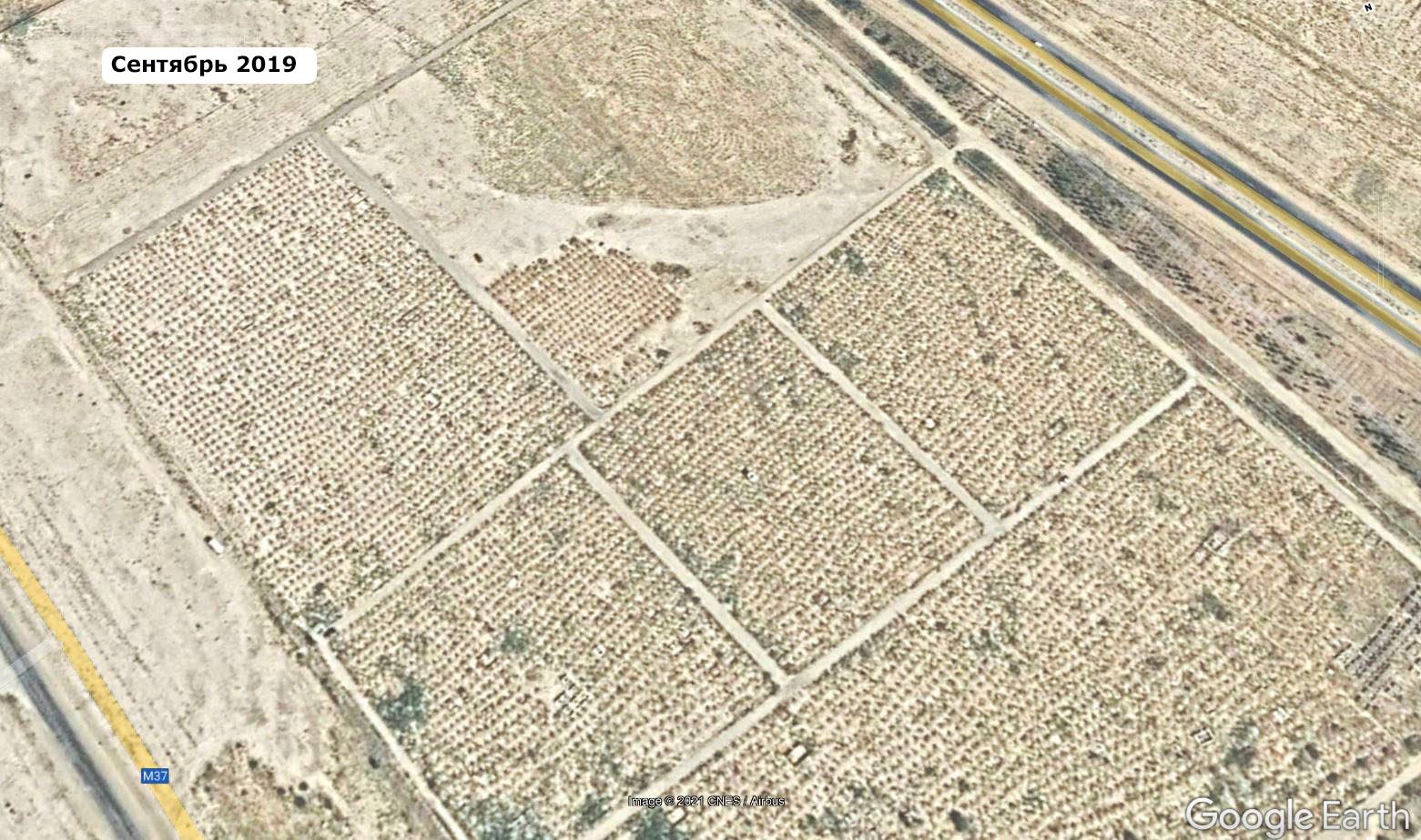According to the statistical data, nearly 53 thousand citizens of five Central Asian countries have died in two years of the coronavirus pandemic. According to the available data, the number of direct or indirect victims of COVID-19 was five times more. Moreover, the majority of “excessive” lethal cases in Kazakhstan, Uzbekistan, Kyrgyzstan and Tajikistan happened not because of the coronavirus infection.
They could live
According to WHO standards, excess mortality is considered a more objective and comparable measure that accounts for both the direct and indirect impacts of the pandemic. They include all-cause mortality. Moreover, their number exceeds the number of lethal cases in ‘normal’ conditions. These are the deaths that could be avoided, if it wasn’t for the pandemic.
The scientific online website, OurWorldindata.org, publishes relative data that allow to compare the excessive mortality statistics not only between the countries, but also over time. According to this database, the mortality rate in Uzbekistan and Kyrgyzstan in early 2020 did not differ from the 2019 level. In Kazakhstan, the excessive mortality indicator was negative. It means that the imposed strict epidemiologic restrictions (including movement restrictions) amid low morbidity rates allows to decrease the number of lethal cases at the onset of the pandemic.
The first year of the pandemic showed that Central Asian countries had a rapid increase in excess mortality. The rates were different in every country. The lowest rate was in Uzbekistan, where in December 2020 516 excess deaths were registered per 1 million people. In Tajikistan and Kyrgyzstan, the indicator was twice as high – 1,012 and 941, respectively. Kazakhstan showed the largest trend – 1,463 cases per 1 million people.
This republic demonstrated the highest excess mortality rate at the end of 2021 – 4,247 excess lethal cases (per 1 million people). Last December, Kyrgyzstan ranked the second with 2,192 cases. The lowest figures belong to Tajikistan and Uzbekistan.
Compared to some developed countries, the excess mortality in Tajikistan and Uzbekistan is at the same level with Germany, France and Switzerland. Nevertheless, the incidence of diseases in these countries is uneven. Given this analogy, it is important to take into account the variations in population pyramids in European and Central Asian countries. Central Asian states have a high proportion of young people, while European states are deemed ageing. This is confirmed by the World Bank’s data. It exposes the Old World countries to a more vulnerable position as senior citizens are at a higher risk of incidence and complications after Covid-19.
On March 10, 2022, a group of international scholars published the results of studies “Estimating excess mortality due to the COVID-19 pandemic: a systematic analysis of COVID-19-related mortality” in the oldest medical journal, The Lancet. They analysed the data of reported mortality from coronavirus and the number of excess deaths in 181 world countries in 2020-2021. According to their estimates, 18.2 million people died worldwide because of the pandemic. However, national governments officially reported 5.9 million deaths because of the coronavirus, which is at least three times less than the general number of excess deaths.
In Central Asia, the difference in numbers is even bigger. The aggregate data provided by the authors show that 52.8 thousand people died because of the coronavirus in the region for two years. However, the number of excess deaths exceeds this number by 5.3 times. Let’s see the situation in every country.
Uzbekistan
According to the State Statistical Committee of Uzbekistan, in 2020-2021 Uzbekistan fought against the consequences of the pandemic more successfully than its neighbours in the region. In the first year of the virus transmission, the number of deaths in Uzbekistan was higher than that in 2019 by only 13 per cent (per 21 thousand people), and in the following year, the increase stopped.
Looking closer at the main causes of mortality, it becomes obvious that the main increase in excess mortality was caused not by respiratory diseases (only every third case), but rather by the sharp increase in the mortality from cardiovascular diseases (58 per cent).
Kazakhstan
The first year of the pandemic showed the record high mortality rate in the last decade in Kazakhstan. If the country had nearly 130-133 thousand deaths a year before the COVID-19, in 2020, 162.6 thousand citizens (+22 per cent) died in 2020 in the republic. 29 thousand cases are considered excess deaths. This is the data provided in the demographic yearbook by the Bureau for National Statistics of the Republic of Kazakhstan.
By mortality structure, the situation in Kazakhstan differs from the one in Uzbekistan. Lung diseases, including influenza, acute respiratory disease, pneumonia, were indicated as cause of death only in 24 per cent of cases in 2020. The proportion of excess deaths because of the circulatory diseases was 22 per cent. Cardiovascular diseases were often the cause of death in 2021. Last year, mortality from lung diseases was 11 per cent less, yet still high based on the pre-pandemic level.
The dynamics of mortality from respiratory diseases, including pneumonia, can be explained by the emergence of COVID-19, but regarding other groups of diseases the coronavirus became a catalyst of systemic problems in healthcare system. It becomes evident from the statistical yearbook ‘Kazakhstan in 2020’. It shows that the number of citizens provided with healthcare services at the outpatient clinics or in emergency care units in 2020 was reduced by 1 million people (by 11 per cent). According to the statistics, in the first year of the pandemic there were fewer patients firstly diagnosed with “diseases of the blood and blood-forming organs and certain disorders involving the immune mechanism” – by 15 per cent, “neoplasms” – by 6 per cent. This cannot be considered the progress. In fact, mortality from these nosologies has only increased, so it’s just the sign of a low level of primary health care.
“During strict lockdowns in spring 2020, we were banned from going outdoors, not to speak of medical check-ups or visits to doctors for some non-urgent issues as compared to the coronavirus. In Ust-Kamenogorsk, where I lived at that time, there was a permit system in place, and we could go shopping or to a pharmacy on “our” days only. Residents of houses with even numbers could go out on even days, with odd numbers – on odd days, respectively. [...] In those difficult times, we worried about not catching both the new virus and something else because it was unrealistic to visit a doctor,” Nadezhda Konovalova, resident of Eastern Kazakhstan region, said.
In 2021, ‘Sange’ Research Centre (Kazakhstan Association of Public Opinion and Market Researchers) with the support of the Soros Foundation, conducted a sociological survey to assess the scope of issues caused by the coronavirus in Kazakhstan. As part of this work, sociologists held public opinion polls. Nearly 27 per cent of respondents said that saw the “shortage of medications, necessary medical equipment, means and beds in hospitals” in 2020. 5.7 per cent mentioned such problem as the speculation in medications, and 5.1 per cent said about the large-scale morbidity and high mortality. Some respondents reported such situations as denial of hospitalisation by ambulance officers, hospital admission refusals, unavailability of diagnostic tests (CT), shortage of necessary medications in pharmacies.
“Only 6.1 per cent of respondents indicated the disease as the problem. The people were more concerned about their financial standing, access to healthcare services and medications, rather than about the risk of falling ill,” experts of ‘Sange’ Centre concluded.
Kyrgyzstan
In Kyrgyzstan, the first two years of the pandemic showed mortality that exceeded the “normal” rate by 20 per cent. In 2019, 33.2 thousand people died in the country, and in 2020-2021, 39.9 and 39.1 thousand, respectively (data of the National Statistical Committee of the Kyrgyz Republic).
As shown on the chart, the biggest proportion of excess deaths in 2020 in Kyrgyzstan was from circulatory diseases (56 per cent), from COVID-19 – only 36 per cent (2.4 thousand cases). It should be noted that Kyrgyzstan is the only country in Central Asia that officially marks out deaths caused by coronavirus in the national statistical system.
Tajikistan
Tajikistan does not have such a transparency. The official statistics gives information only about the number of deaths, without distinguishing them by ICD (International Classification of Diseases) codes. According to the Statistics Agency of Tajikistan, in 2020, the number of deaths in the country increased by 27 per cent (by 9 thousand), in 2021, by 28 per cent more (by 12.3 thousand). However, according to official data, only 124 people died from COVID-19 from May 2020 to December 2021. This is the information provided by the Single National Website on coronavirus covid.tj.
The research published by The Lancet provides information on the assumed mortality caused by COVID-19 in Tajikistan. According to this data, the number of excess deaths is 115 times higher than the figure provided by the official authorities.
Turkmenistan
The editorial staff did not include Turkmenistan in the list of surveyed countries when collecting data for infographics and case study in Central Asia for a reason. This was done because the State Committee for Statistics of Turkmenistan does not publish digital information on mortality neither by the number of deceased, nor by causes of death. Large-scale international data banks do not have such data either.
To assess the mortality dynamics, local journalists use unconventional methods. For example, Turkmen.news reporters compare the satellite images of local cemeteries in the beginning of the pandemic and those taken one and a half years later. The photos show how big became the burying place.
Photo: turkmen.news
When discussing the pandemic in global media, Turkmenistan stood out for the fact that its ex-president Gurbanguly Berdymukhamedov was repeatedly saying that there was not a single case of COVID-19 registered in the country. One year after the pandemic beginning, the national government kept to the same policy – no virus in the country. The word “coronavirus” was banned from use in local media outlets.
In September 2021, several large-scale public human rights organisations of Turkmenistan addressed the open letter to Hans Kluge, WHO Regional Director for Europe. They asked him to publicly challenge the Turkmen government regarding its promise to provide with biological material of patients with COVID-19 symptoms so that they can be tested by independent laboratories. In fact, the civil society demanded to admit the pandemic in the country.
“We are convinced that it is the state bodies’ denial since 2020 of COVID-19 in Turkmenistan and the ban on the free dissemination and receipt of information that have resulted in public ignorance about the imminent threat. These are some of the main reasons for the growing number of COVID-19 cases and deaths,” according to the letter signed by the heads of several community-based organisations. Among them were Turkmen Helsinki Foundation for Human Rights, Democratic Civil Union, Turkmenistan Independent Lawyers Association, Turkmen Initiative for Human Rights.

Farid Tukhbatullin, leader of the Turkmen Initiative for Human Rights, also signed the letter addressed to Mr. Kluge. Unfortunately, no author of the letter received direct response.
“After we sent the letter, Hans Kluge decided to visit Turkmenistan. On October 8, 2021, he met with Gurbanguly Berdymukhamedov, who once again said that there is no Covid in Turkmenistan. As Kluge said to local media, ‘we have agreed to hold the WHO technical mission in the nearest time to improve work under international standards,’” said the head of the Turkmen human rights organisation to CABAR.asia.
He said that civil activists have no efficient channels of communication with the country’s leadership. Letters addressed to the president, ministries, parliament, ombudsman remain unanswered. Sometimes, appealing to international facilities is in vain.
The authors of the global study published by The Lancet think that governments’ recognition of excess mortality as the total number of lethal cases caused by coronavirus will become the crucial first step in fighting the pandemic. It is recognition rather than denial of the problem can resolve it more efficiently now and in case of future epidemics.




